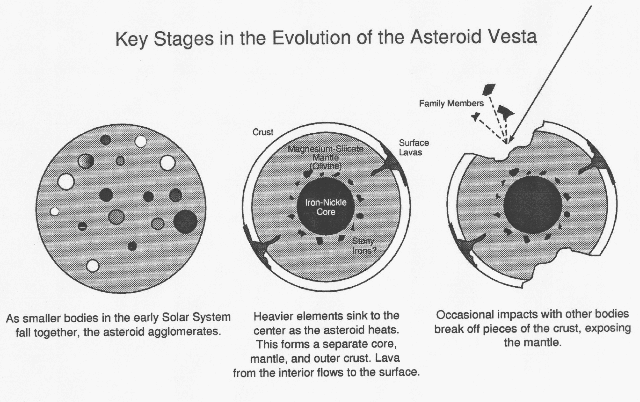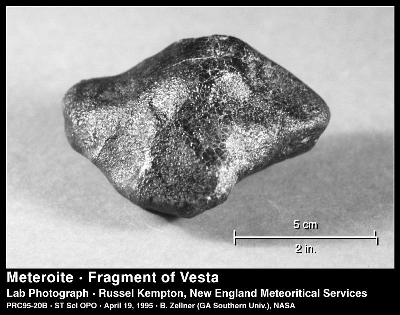
NASA's Hubble Space Telescope images of the asteroid Vesta are providing astronomers with a glimpse of the oldest terrain ever seen in the solar system and a peek into a broken off section of the "mini-planet" that exposes its interior.

Astronomers believe that fragments gouged out of Vesta during ancient collisions have fallen to Earth as meteorites, making Vesta only the fourth solar system object, other than Earth, the Moon and Mars, where scientists have a confirmed laboratory sample. "The Hubble observations show that Vesta is far more interesting than simply a chunk of rock in space as most asteroids are," said Ben Zellner of Georgia Southern University. "This qualifies Vesta as the 'sixth' terrestrial planet."
No bigger than the state of Arizona, Vesta offers new clues to the origin of the solar system and the interior makeup of the rocky planets. "Vesta has survived essentially intact since the formation of the planets," Zellner said. "It provides a record of the long and complex evolution of our solar system." Resolving features down to 50 miles across, Hubble reveals a surprisingly diverse world with an exposed mantle, ancient lava flows and impact basins. Though only 325 miles (525 kilometers) across, it once had a molten interior. This contradicts conventional ideas that asteroids essentially are cold, rocky fragments left behind from the early days of planetary formation.
Besides providing scientists with direct samples, Vesta's chipped surface allows Hubble to study the asteroid's rocky mantle, giving scientists a unique opportunity to see what a planet looks like below the crust. Vesta is the most geologically diverse of the large asteroids and the only known one with distinctive light and dark areas -- much like the face of our Moon. Previous ground-based spectroscopy of Vesta indicates regions that are basaltic, which means lava flows once occurred on its surface. This is surprising evidence that the asteroid once had a molten interior, like Earth does.
One possibility is that Vesta agglomerated from smaller material that includes radioactive debris (such as the isotope Aluminum-26) that was incorporated into the core. This radioactive "shrapnel" probably came from a nearby supernova explosion. (In fact a supernova might have triggered the birth of our solar system.) This hot isotope may have melted the core, causing the asteroid to differentiate: heavier, dense material sank to the center while lighter rock rose to the surface. This is a common structure for the terrestrial planets. After Vesta's formation, molten rock flowed onto the asteroid's surface. This happened more than four billion years ago. The surface has remained unchanged since then, except for occasional meteoroid impacts.

One or more large impacts tore away some of the crust exposing a deeper mantle of olivine, which is believed to constitute most of the Earth's mantle. Some of the pieces knocked off Vesta have fallen to Earth as meteorites, which show a similar spectral fingerprint to Vesta's surface composition.
In October 1960, two fence workers in Millbillillie, Western Australia, observed a fireball heading toward the ground, and pieces of the fallen meteorite were found ten years later. The fragments stood out from the area's reddish sandy soil because they had a shiny black fusion crust, produced by their fiery entry through Earth's atmosphere.

Unlike most other meteorites, this sample can be traced to its parent body, the asteroid Vesta. The meteorite's chemical identity points to Vesta because it has the same unique pyroxene spectral signature. Pyroxine is common in lava flows, meaning that the meteorite was created in an ancient lava flow on Vesta's surface. The structure of the meteorite's mineral grains also indicates it was molten and then cooled. The isotopes (oxygen atoms with varying number of neutrons) in the specimen are unlike the isotopes found for all other rocks of the Earth, Moon and most other meteorites.
The meteorite also has the same pyroxene signature as other small asteroids, recently discovered near Vesta, that are considered chips blasted off Vesta's surface.
Space Telescope Science Institute
 |
 |